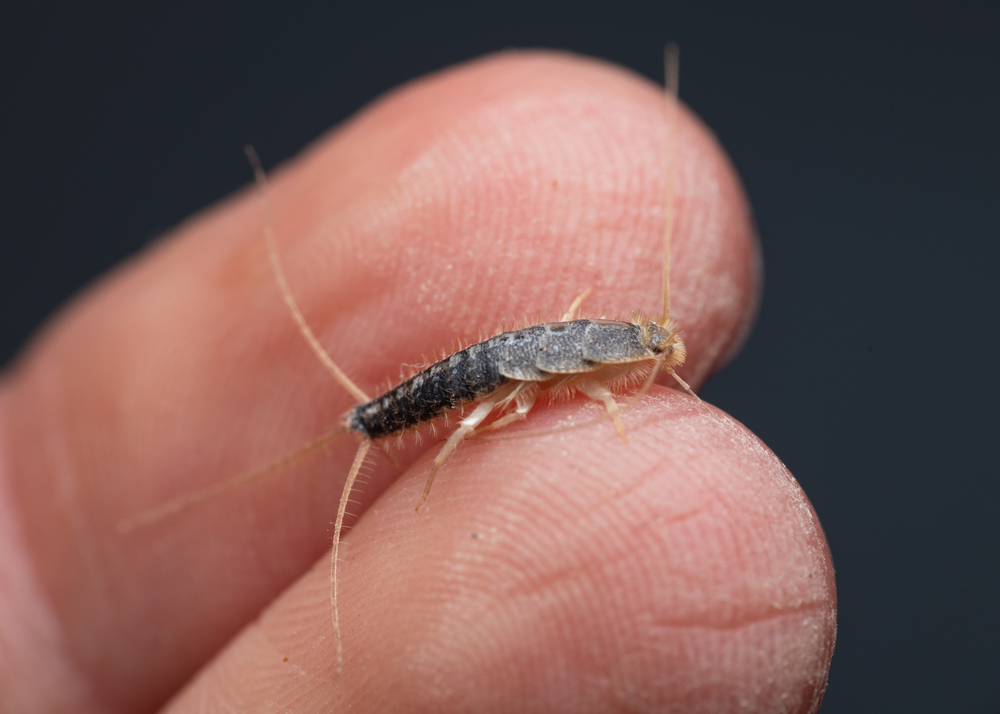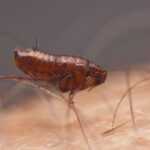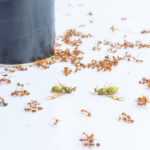Top Tips to Get Rid of the Silverfish Bug for Good
Dealing with a silverfish bug problem at home? Silverfish are small, wingless bugs with a silvery appearance and a distinctive metallic appearance, known for infesting dark, damp areas. They damage household items like books and clothes. This article covers everything you need to know about identifying and getting rid of silverfish bugs.
Silverfish Bug Control
- Silverfish are resilient nocturnal pests that thrive in dark, damp areas of the home, making moisture control essential for prevention.
- They feed primarily on starchy materials and carbohydrates, which can cause damage to household items such as books, wallpaper, and clothing.
- Effective eradication methods include using traps, insecticides, and dehumidifiers, while professional pest control services may be necessary for severe silverfish bug infestations.
Understanding the Silverfish Bug
Silverfish are a type of insect and belong to a primitive species that has been around for over 400 million years. They are wingless, elongated, and have a teardrop-shaped body covered in silvery-gray scales, which give them their common name. Measuring between 0.5 to 1 inch in length, silverfish possess long antennae and move with a distinctive wiggling motion that mimics the swimming of fish. Their soft, flattened bodies are often left behind as remnants after molting or death, and these bodies may be found in humid, dark areas prone to infestation. This unique movement, combined with their tapered abdomen, gives them a fish-like appearance, hence the name silverfish.
Silverfish are sometimes confused with other household pests like earwigs, but earwigs have pincers at the end of their abdomen and a darker, more robust body, while silverfish are slender, lack pincers, and have a silvery sheen.
Newly hatched silverfish start white but gain their shiny grayish color as they mature. These insects are incredibly resilient and can survive in a variety of environments, making them a common household pest. Unlike many other insects, silverfish do not have wings, but their ability to move quickly allows them to evade predators and hide in small crevices around your home.
Recognizing their physical characteristics and behavior is key to controlling a silverfish infestation. Their silvery appearance and fish-like movement distinguish them from other household bugs. Identifying these features early can help you tackle a potential silverfish problem before it escalates.
Where Do Silverfish Live?
Silverfish are nocturnal creatures, preferring to hide in dark, damp areas of your home during the day and emerging at night to forage for food. Common indoor habitats include basements, bathrooms, kitchens, laundry rooms, and crawl spaces, where they can find both moisture and food sources. These areas offer the cool, damp environments that silverfish thrive in, with optimal temperatures ranging between 72 and 80 degrees Fahrenheit. Silverfish are often found indoors in moist areas such as crawl spaces, laundry rooms, and basements, making these locations key spots to inspect for silverfish infestations. Urban silverfish are especially prevalent in city homes and apartments, thriving in undisturbed, humid environments.
Silverfish also thrive in places where books, cardboard, and starchy materials are stored. Bookshelves, storage spaces with cardboard boxes, and closets offer both shelter and food. Female silverfish lay silverfish eggs in cracks and crevices, often entering homes via cardboard boxes, so vigilant storage practices are important.
Outside, silverfish are commonly found under rocks and leaf litter, areas that offer the moisture they need to survive. Regions with high humidity, like Florida, are particularly prone to silverfish infestations, especially in homes that are not properly dehumidified. Understanding where silverfish live can help you target your efforts to eliminate them and prevent future infestations.
What Do Silverfish Eat?
Silverfish have a voracious appetite for starchy materials, and their feeding can cause significant damage to household items. They are particularly attracted to starchy foods, such as flour, cereal, pasta, and rolled oats. Pet food is another item that silverfish may contaminate. This means that your pantry can be a prime target for these pests. In addition to food items, silverfish also feed on paper, fabrics, and other organic materials, including book bindings, old books, and wallpaper.
Silverfish also consume dead insects, making them opportunistic feeders. Their diverse diet and ability to survive on minimal resources make them particularly difficult to eradicate once established. Understanding their feeding habits helps in identifying their presence and eliminating food sources.
Signs of a Silverfish Infestation
Detecting a silverfish infestation early on can save you a lot of trouble down the road. To find silverfish, inspect typical hiding spots such as dark, humid areas like basements, attics, and around stored items, and look for signs of their presence. One of the most obvious signs is frequent sightings of silverfish in areas like the kitchen, bathroom, or attic. Silverfish are notorious for causing damage to personal belongings, especially items made of paper or starch, such as books, wallpaper, and clothing.
Other indicators include the presence of silverfish droppings, which resemble small black peppercorns, and yellow stains on fabrics caused by their urine. These signs can often be mistaken for general debris or dirt, but they are telltale indicators of a silverfish problem. Additionally, finding shed exoskeletons or skin molts can also confirm their activity in your home.
Seeing Silverfish Bugs Around the Home
Spotting silverfish around your home clearly indicates an infestation. These wingless insects often scurry away when lights are turned on, showing they are active in your living spaces.
Frequent sightings of silverfish strongly indicate a more significant silverfish bug problem that needs immediate attention.
Silverfish droppings, resembling small black peppercorns or tiny ball bearings, are another sign of an infestation. These droppings are often found near bookshelves, storage boxes, and other dark, damp places. Due to their small size and dark color, they can be mistaken for dirt, so vigilance is necessary.
Yellow stains from silverfish urine on fabrics, papers, and other surfaces also indicate their presence. A yellowish dust often accompanies these stains, further confirming silverfish activity.
Droppings and yellow stains are key signs to watch for, aiding in the early identification and addressing of a silverfish infestation.
Skin Molts
Silverfish molt throughout their lives, leaving shiny, opaque exoskeletons. Discovering these shed skins in areas where silverfish live reliably indicates their presence.
Molts are often found in dark, hidden places like closets, attics, and behind furniture, indicating ongoing silverfish bug activity.
Are Silverfish Harmful
Silverfish are nuisance pests rather than direct threats to human health. They do not bite, sting, or carry harmful diseases. However, they can contaminate food with their feces, posing a minor health risk if consumed.
Silverfish cause significant damage to household items by chewing through paper, fabrics, and some types of glue, damaging books, wallpaper, and clothing. Promptly addressing an infestation prevents further damage to your belongings.
Preventing Silverfish Infestations
Proactively preventing a silverfish infestation, especially by controlling moisture levels, is key. Silverfish thrive in humid environments, so reducing moisture is essential. Dehumidifiers can effectively lower humidity levels, making your home less hospitable to these pests.
Proper ventilation and sealing leaky pipes also help minimize moisture, reducing the risk of infestation. Storing papers, books, and other starchy materials in sealed containers deters silverfish from invading storage spaces. Immediate action can prevent an infestation from worsening.
Maintaining low humidity levels in attics and other storage areas is particularly important, as these spaces can become prime habitats for silverfish. These preventative measures significantly reduce the likelihood of an infestation.
How to Get Rid of Silverfish
Facing a silverfish infestation requires immediate action to prevent it from spiraling out of control. Several methods are available, from DIY solutions to professional pest control services. One effective DIY method is using a HEPA vacuum to remove both silverfish and their eggs.
If DIY methods fail, consider professional pest control services. Experts provide comprehensive solutions that address the root of the problem and prevent future infestations of nuisance pests.
The following subsections explore different strategies for eliminating silverfish bugs from your home.
Traps and Insecticides
Using bait traps or insecticides is a common method to control silverfish populations. Traps placed in frequently seen areas like bathrooms, kitchens, and basements attract and capture silverfish, reducing their numbers over time. Insecticides kill silverfish on contact, providing an immediate solution.
Controlling silverfish populations prevents damage to household items and maintains a clean living environment. While traps and insecticides can be effective, use them with caution, especially in homes with pets or children. Follow the manufacturer’s instructions to ensure safety and effectiveness.
Dehumidifiers and Essential Oils
Essential oils, such as lavender, cedar, and citrus, can naturally deter silverfish. Cedar oil, in particular, repels silverfish from clothing stored in closets. Apply these oils to cotton balls and place them in active areas.
Using dehumidifiers to maintain lower humidity levels can reduce silverfish populations. Keeping humidity below 60% creates an environment less favorable for silverfish, especially in humid areas and damp areas like basements, bathrooms, and attics.
Room-by-Room Silverfish Bug Control Tips
Different areas of your home require unique strategies to manage and eliminate silverfish bugs effectively. Each room presents its own challenges and needs tailored approaches for comprehensive control. Addressing specific conditions in each room creates an inhospitable environment for silverfish.
Clearing debris and organic matter from around your home decreases the likelihood of silverfish infestations. The following subsections provide room-by-room tips to control and prevent silverfish bugs in your bathroom, kitchen, closet, and attic.
Bathroom Silverfish Control
Bathrooms are common hotspots for silverfish due to high moisture levels. Proper ventilation using exhaust fans and reducing moisture can prevent infestations. Sticky and DIY traps can effectively control silverfish populations in bathrooms.
Sealing cracks and openings with caulk prevents silverfish from entering your home. Addressing these areas significantly reduces their presence in your bathroom, maintaining a cleaner, pest-free environment.
Kitchen Silverfish Control
Silverfish are often found in the kitchen, attracted by food sources and moisture. Storing dry foods in airtight containers prevents silverfish access. Regular cleaning and vacuuming eliminate crumbs and food particles that attract them.
Preventing silverfish access to food is key to deterring infestations. Maintaining a clean and organized kitchen reduces the risk of silverfish and other pests invading your food storage areas.
Closet Silverfish Control
Closets are ideal hiding spaces for silverfish due to their dark, cool conditions. Traps or essential oils can effectively repel them from closets. Regularly dusting your home reduces the particles that attract silverfish.
Removing old newspapers and cardboard, which attract silverfish with their starch content, is important. Boric acid or diatomaceous earth traps can eliminate existing silverfish in closets. Keeping closets clean and clutter-free deters silverfish from settling there.
Attic Silverfish Control
Neglected attics provide an ideal environment for silverfish. These cool, dark spaces are conducive to silverfish activity, especially with moisture present. Traps and dehumidifiers can effectively control silverfish populations in attics.
Maintaining indoor humidity levels below 60% significantly deters silverfish from thriving. Regularly inspecting and cleaning your attic, and storing items in sealed containers, help prevent silverfish from establishing a foothold in this part of your home.
Silverfish Bug Identification and Control
Silverfish are resilient pests that thrive in dark, damp environments and have a diverse diet that can lead to significant damage to household items. Identifying the signs of a silverfish infestation early, such as sightings, droppings, yellow stains, and skin molts, is crucial for timely intervention. While silverfish are not harmful to human health, their presence can be a nuisance and cause considerable damage to personal belongings.
Preventing and controlling silverfish infestations requires a multi-faceted approach, including moisture control, proper storage practices, and the use of traps and insecticides. In cases of severe infestations, professional pest control services like Gopher Patrol offer effective and comprehensive solutions. By following the tips and strategies outlined in this guide, you can keep your home silverfish-free and protect your belongings from these persistent pests.
Frequently Asked Questions
Should You Kill Silverfish Bugs?
It is not necessary to kill silverfish as they are not harmful to humans, but if their population becomes excessive and they start damaging belongings, control measures may be warranted.
Are Silverfish Bugs Harmful to Humans?
Silverfish are not harmful to humans as they do not bite or spread diseases; however, they can cause damage to household items and may pose a risk to food through contamination. It is advisable to monitor for their presence in dark, damp areas.
What Causes Silverfish Bugs in the Home?
Silverfish infestations in the home are primarily caused by damp and humid conditions, often indicating potential water issues such as leaks or external moisture. They can also enter through cracks and infested items.
Should I Be Worried if I Have Silverfish Bugs?
You need not be overly concerned about silverfish as they do not pose a direct health threat to humans; however, they can contaminate food and potentially cause damage to your belongings. It is advisable to monitor your environment and take steps to manage any infestations.
How Can I Identify a Silverfish Bug Infestation?
You can identify a silverfish infestation by spotting the insects themselves, finding droppings that look like small black peppercorns, observing yellow stains on fabrics, and discovering shed exoskeletons. These indicators are crucial for recognizing an infestation.





